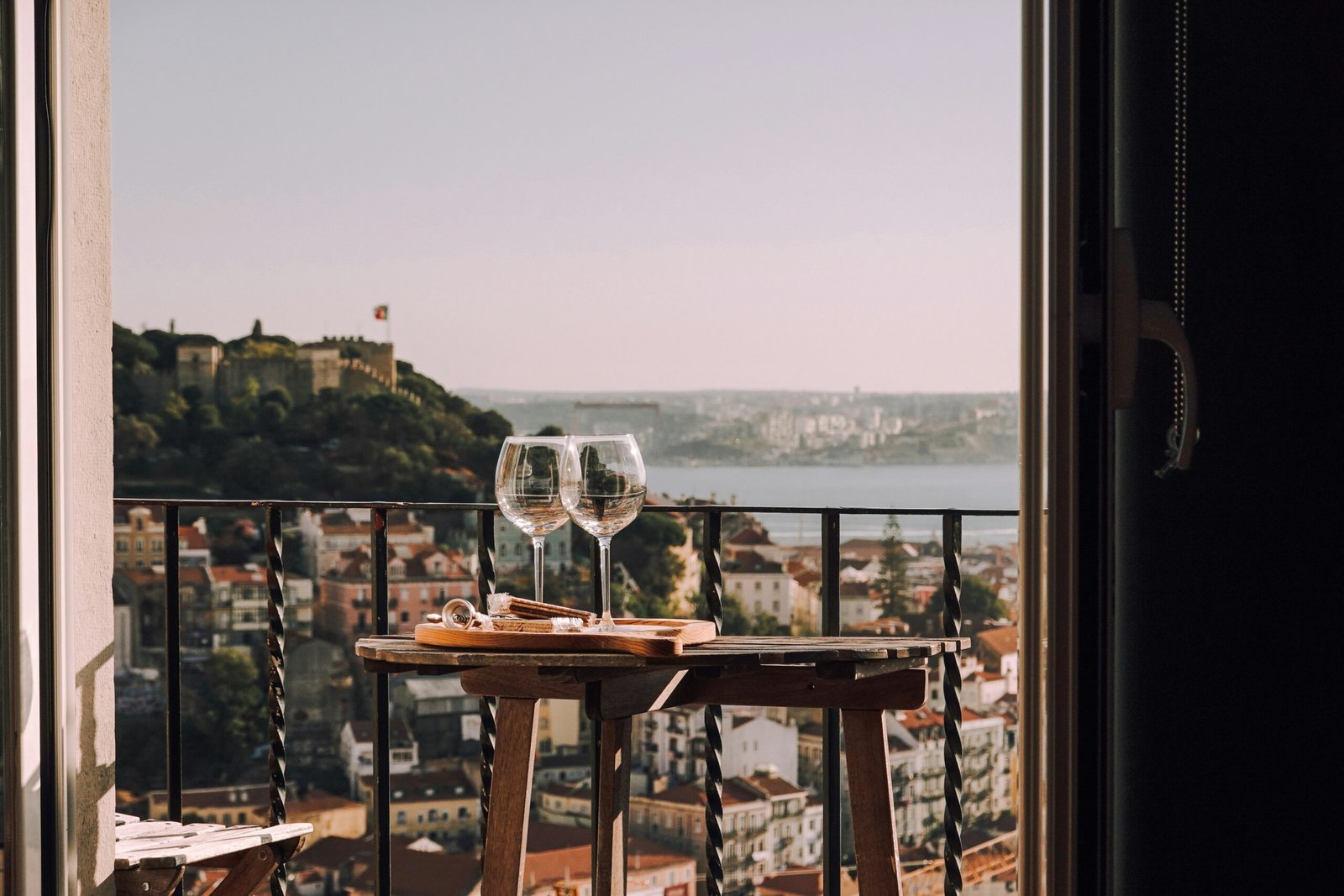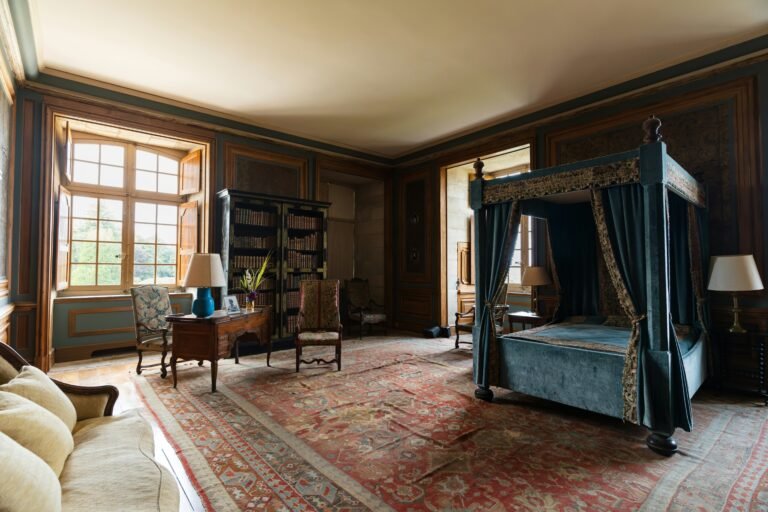Transforming your city apartment balcony into a Mediterranean-inspired retreat is an achievable and rewarding endeavor. By incorporating elements reminiscent of coastal charm, you can create an oasis that evokes the warmth and relaxation of the Mediterranean, even in an urban setting.
1. Embrace a Mediterranean Color Palette
Start by selecting colors that reflect the Mediterranean landscape:
- Whites and Creams: These hues provide a clean, airy base.
- Terracotta and Ochre: Inspired by sunbaked earth and traditional tiles.
- Blues and Turquoises: Echoing the sea and sky.
Use these colors in your furnishings, textiles, and decorative accents to set the tone.
2. Incorporate Natural Materials
Mediterranean design emphasizes natural, rustic materials:
- Wood: Opt for teak or acacia furniture for durability and warmth.
- Wrought Iron: Use in railings, furniture frames, or decorative pieces.
- Clay and Terracotta: Ideal for pots and tiles, adding texture and color.
These materials bring authenticity and a tactile quality to your balcony.
3. Select Appropriate Furniture
Choose furniture that balances comfort with the Mediterranean aesthetic:
- Bistro Sets: Compact and perfect for dining al fresco.
- Lounge Chairs or Daybeds: Encourage relaxation and mimic coastal resorts.
- Built-in Benches: Maximize space and can be adorned with cushions.
Ensure fabrics are weather-resistant and in keeping with your color scheme.
4. Add Lush Greenery
Introduce plants that thrive in Mediterranean climates:
- Olive Trees: Symbolic and well-suited to container growing.
- Lavender and Rosemary: Provide fragrance and attract pollinators.
- Bougainvillea: Offers vibrant color and can be trained along railings.
Use terracotta pots to enhance the Mediterranean feel.
5. Incorporate Textiles and Patterns
Textiles add comfort and visual interest:
- Cushions and Throws: Choose fabrics with geometric or floral patterns common in Mediterranean design.
- Outdoor Rugs: Define spaces and add softness underfoot.
- Curtains or Canopies: Provide shade and a sense of enclosure.
Opt for natural fibers like cotton or linen for breathability.
6. Utilize Decorative Accents
Small details can significantly impact the ambiance:
- Lanterns and Candle Holders: Create a warm, inviting glow in the evenings.
- Ceramic Tiles: Use as tabletops or wall accents for color and pattern.
- Mirrors: Reflect light and make the space feel larger.
These elements contribute to the overall charm and character of your balcony.
7. Optimize Lighting
Lighting extends the usability of your balcony into the evening:
- String Lights: Drape overhead for a festive atmosphere.
- Solar-Powered Lamps: Eco-friendly and practical.
- Wall Sconces: Provide focused lighting and can be decorative.
Aim for warm-toned lights to enhance the cozy ambiance.
8. Incorporate Water Features
The sound of water adds tranquility:
- Tabletop Fountains: Compact and suitable for small spaces.
- Wall-Mounted Waterfalls: Save floor space and add visual interest.
Ensure the feature is proportionate to your balcony size.
9. Personalize with Art and Accessories
Infuse your personality into the space:
- Wall Art: Choose pieces that reflect Mediterranean themes.
- Decorative Objects: Include items like seashells, driftwood, or artisanal crafts.
- Books and Magazines: Create a cozy reading nook.
These touches make the space uniquely yours.
10. Maintain Functionality and Comfort
Ensure your balcony meets your lifestyle needs:
- Storage Solutions: Use benches with hidden compartments.
- Weather Protection: Install retractable awnings or umbrellas.
- Privacy Screens: Use lattice panels or tall plants to create seclusion.
Balancing aesthetics with practicality ensures long-term enjoyment.
11. Add a Touch of Tilework for Authentic Mediterranean Flair
One of the hallmarks of Mediterranean design is the use of colorful, intricate tiles. These can instantly transport you to the streets of Santorini or a courtyard in Seville.
Tile Ideas for Small Balconies:
- Mosaic Bistro Tables: Functional and decorative—perfect for coffee or wine al fresco.
- Tile Rugs: Use patterned outdoor tiles to mimic the look of a traditional rug, defining space and adding a burst of color.
- Wall Accents: Tile a small section of your balcony wall to act as a backsplash or decorative focal point.
Stick to traditional Mediterranean patterns—think geometric blues, sun motifs, or Moorish-inspired designs—to keep it authentic.
12. Bring in Mediterranean-Inspired Scents
To fully transport your senses to the Mediterranean, you can’t overlook fragrance. Scent can deeply affect ambiance, making your balcony not just a visual but a sensory escape.
Fragrant Touches to Consider:
- Herb Planters: Basil, oregano, thyme, and mint not only smell great but are perfect for culinary use.
- Citrus Plants: Dwarf lemon or orange trees bring a fresh, zesty aroma.
- Scented Candles or Oil Diffusers: Choose scents like bergamot, lavender, fig, or sea salt.
This olfactory detail rounds out the coastal charm and enhances your space’s calming vibe.
13. Use Coastal-Inspired Decor Accents
Infuse subtle nods to the sea with a few beach-inspired pieces. Even in the middle of a city, these touches can evoke the laid-back luxury of a seaside terrace.
Popular Mediterranean Decor Touches:
Keep it understated—too many seaside motifs can feel kitschy. A few well-placed accents go a long way.
14. Set the Mood with Mediterranean Music and Lifestyle Elements
Design is not just what you see—it’s also how you feel. Turn your Mediterranean balcony into a full experience by curating the atmosphere.
- Bluetooth Speakers: Play relaxing instrumental guitar, soft flamenco, or Greek folk music in the background.
- Evening Rituals: Keep a tray for tea, tapas, or a glass of rosé—make this balcony your nightly ritual.
- Books and Journals: Keep a basket nearby to encourage slower, mindful moments.
With these lifestyle cues, your balcony becomes more than a design statement—it becomes a daily retreat.
15. Add Vertical Gardens with Mediterranean Flair
Vertical gardening is a smart way to bring the lush feeling of a Mediterranean courtyard to a tight urban space.
Mediterranean Vertical Garden Ideas:
- Wall-Mounted Planters: Fill with herbs, cascading vines, or flowering plants.
- Ladder Shelves: Use reclaimed wood to create a rustic plant stand.
- Hanging Baskets: Choose natural fibers like jute or seagrass for an earthy look.
Keep a mix of green foliage and flowering plants like geraniums or jasmine to mimic the textures and colors of the Mediterranean coast.
16. Incorporate Shadow and Shade the Mediterranean Way
Shade is an essential part of Mediterranean life—not just for comfort, but also for creating drama and contrast in design.
Ways to Introduce Stylish Shade:
- Bamboo or Reed Roof Panels: Filter sunlight beautifully and add texture.
- Sheer Curtains: Billow softly in the breeze while offering privacy and elegance.
- Trellises with Vines: Grow grapevines, jasmine, or ivy to create natural cover overhead.
The interplay of light and shadow creates visual depth and a relaxing mood that shifts with the sun’s movement throughout the day.
17. Create Intimate Seating Areas
Mediterranean balconies often encourage slow, soulful living. That means having at least one spot dedicated to lounging, napping, or curling up with a book.
Intimate Seating Ideas:
- Low Bench with Cushions: Add oversized pillows for a Moroccan-inspired look.
- Hammock Chair: A boho-chic touch that invites hours of relaxation.
- Poufs and Floor Seating: Great for low tables and spontaneous gatherings.
Don’t forget to add side tables or trays to hold books, drinks, or plants—convenience is key to enjoying your balcony fully.
18. Choose Sustainable, Handcrafted Pieces
Many Mediterranean cultures value craftsmanship and sustainability, so include handmade or upcycled elements to echo this ethos.
Sustainable Mediterranean Touches:
- Handwoven Rugs: Choose jute, seagrass, or cotton.
- Artisanal Ceramics: Use handcrafted pottery for planters, mugs, or decorative plates.
- Repurposed Materials: Turn wine crates into plant boxes, or old doors into tables.
Supporting local artisans or buying secondhand also adds story and soul to your outdoor sanctuary.
19. Celebrate Seasonal Living
One of the most inspiring parts of the Mediterranean lifestyle is its deep connection to the seasons. Reflect this on your balcony to keep it fresh and engaging all year long.
Seasonal Switch-Up Ideas:
- Spring/Summer: Lighter linens, fresh citrus plants, bright floral colors.
- Autumn: Switch to terracotta tones, add wool throws, include rustic lanterns.
- Winter: Use cozy textures, add windbreaks or patio heaters, and choose evergreen plants like rosemary or myrtle.
Each season brings an opportunity to connect more deeply with your space—and yourself.
Final Thoughts: Bring the Mediterranean to Your Balcony, One Step at a Time
Creating a Mediterranean balcony isn’t about replicating a beach resort—it’s about capturing the feeling: the warmth, the breeze, the slow sips of coffee or wine, the sense of timeless beauty. Even in the heart of a city, a thoughtfully designed balcony can become a daily retreat—your own slice of the sea.
Key Takeaways:
- Stick to a Mediterranean color palette of whites, terracotta, blues, and neutrals.
- Embrace natural textures like wood, iron, and terracotta for authenticity.
- Add Mediterranean plants like olive trees, lavender, and bougainvillea.
- Include tilework, textiles, and lanterns for layered charm.
- Create a ritual space—somewhere you slow down, sip something, and breathe.
No matter your square footage, the Mediterranean lifestyle is more about attitude than acreage. Start small, stay intentional, and let your balcony evolve into your personal coastal haven.
Alex is the creator of Homely Haven, a space dedicated to simple, stylish ideas for interiors and gardens alike. With a passion for cozy living rooms, inviting outdoor spaces, and practical DIY solutions, Alex shares tips and guides that help turn any house into a true home.
From budget-friendly decorating hacks to weekend garden projects, the goal is always the same: to inspire you to create spaces that feel personal, beautiful, and welcoming. When not writing, Alex is usually rearranging furniture, sketching new garden layouts, or exploring design trends for the next project.








